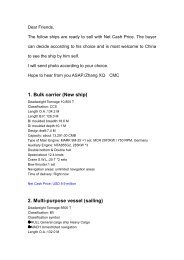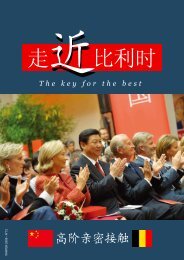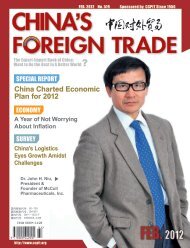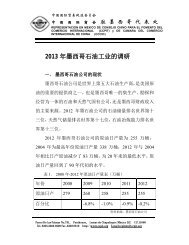Create successful ePaper yourself
Turn your PDF publications into a flip-book with our unique Google optimized e-Paper software.
CNH deposits have always been<br />
the toughest to predict because of<br />
the many moving parts involved.<br />
Offshore liquidity conditions were<br />
tightening for most of 2012. At one<br />
stage, CNH deposits in Hong Kong<br />
were down 13% from their 2011<br />
peak, although the fall was cushioned<br />
as banks raised time-deposit rates to<br />
near or above 3% to attract deposits.<br />
The start of 2013 has seen a sharp<br />
improvement in local CNH liquidity<br />
conditions; this has caused the overnight<br />
deposit rate to collapse to 0.7%<br />
from 2.5% as of December 2012, and<br />
1Y CCS to fall to 2.1% from 2.6%<br />
(Figure 4). Hong Kong commercial<br />
banks CNH time-deposit rates were<br />
generally down by around 10-30bps<br />
across most tenors in the first week of<br />
January.<br />
So what has changed? For<br />
one, monetary conditions in China’s<br />
onshore market eased as a result of<br />
frequent PBoC injections, as well as<br />
a resumption of net capital inflows in<br />
November-December. China’s overnight<br />
interbank repo rate fell to 2% in<br />
January from 2.3-2.5% in December.<br />
Offshore liquidity has also been<br />
boosted by the November return<br />
of the CNH premium over CNY,<br />
which became stickier in December.<br />
A stronger CNH spot rate over<br />
CNY makes foreign exporters more<br />
Figure 4: A bout of flush liquidity at the start of 2013<br />
O/N Renminbi HIBOR and 1Y CCS collapsed to 0.7% and 1.9% (%)<br />
Sources: Bloomberg, Standard Chartered Research<br />
willing to receive Renminbi directly,<br />
and foreign importers will convert<br />
at the CNY spot rate (rather than<br />
CNH spot) via the offshore clearing<br />
bank – i.e., their payments to onshore<br />
will not reduce CNH liquidity<br />
in this case. Chinese importers<br />
should also have a greater incentive<br />
to make cross-border (trade-related)<br />
Renminbi transfers to their offshore<br />
purchasing arms before doing USD<br />
conversion. Such trade settlement<br />
practices may prevent a substantial<br />
widening of the CNH premium,<br />
but we believe a small premium on<br />
the back of mild CNY appreciation<br />
expectations and China’s economic<br />
recovery is sustainable for most of<br />
2013. Chances are that the ratio of<br />
China’s imports to exports settled<br />
in Renminbi will finally start to stabilise<br />
around the Q3-2012 level of<br />
1.2:1:0, after falling consistently since<br />
the launch of the Renminbi trade<br />
settlement pilot scheme in 2009.<br />
Notwithstanding the risk of a<br />
small setback in February – onshore<br />
liquidity typically tightens before the<br />
Lunar New Year (10 February this<br />
year), and redemption of CNH CDs<br />
is particularly strong in February – we<br />
still expect bigger Renminbi inflows<br />
via trade settlement to the offshore<br />
market in 2013 than in 2012. This<br />
will help to balance Renminbi outflows<br />
to the mainland under the<br />
capital account, which are likely to<br />
remain large.<br />
In 2012, combined capital<br />
account outflows from Renminbi<br />
foreign direct investment (FDI),<br />
overseas direct investment (ODI)<br />
and R-QFII drained Hong<br />
Kong’s CNH liquidity pool by<br />
some CNY 260bn, or 45% of<br />
Hong Kong CNH deposits (which<br />
stood at CNY 571bn as of November).<br />
We expect at least CNY<br />
300bn to flow back to mainland<br />
China in 2013, driven by Beijing’s<br />
recent initiatives on cross-border<br />
capital activities, Renminbi FDI,<br />
R-QFII (for which the quota was<br />
significantly expanded recently),<br />
and the Qianhai cross-border<br />
loan programme.<br />
To balance these CNH outflows,<br />
Beijing is under pressure to<br />
allow more capital account CNY<br />
outf lows from China. News of<br />
QDII2, a pilot programme allowing<br />
mainland individuals to invest<br />
overseas utilising onshore funding,<br />
is encouraging, as the same<br />
framework could eventually be<br />
used for a Renminbi-denominated<br />
programme (perhaps R-QDII2).<br />
According to the People’s Bank<br />
of China statement on its annual<br />
work meeting, it has been “proactively”<br />
preparing for the QDII2<br />
scheme, which is likely to be<br />
launched this year. Overseas direct<br />
investment flows will also build in<br />
2013, and a growing share of them<br />
will be denominated in CNY.<br />
Overall, though, we believe rising<br />
CNY inflows to Hong Kong under<br />
the current account will more than<br />
offset rising outflows under the<br />
capital account, resulting in more<br />
liquidity.<br />
CNH deposits of at least<br />
CNY 700bn in Hong Kong by<br />
end-2013 appear reasonable to us<br />
for now; we see a strong case for<br />
CNY 750-800bn, if there is further<br />
capital account liberalisation.<br />
We also look for the RGI to rise<br />
more than 50% this year.<br />
(Authors: from Standard<br />
Chartered Bank)<br />
25

















